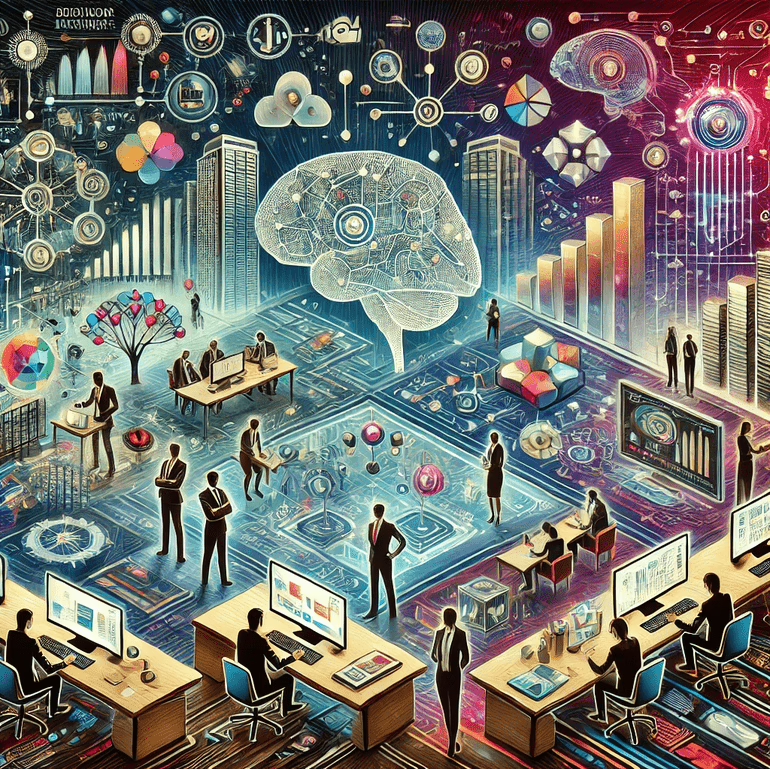In today’s rapidly evolving technological landscape, machine learning (ML) algorithms have emerged as a transformative tool for businesses across industries. These algorithms, a subset of artificial intelligence (AI), enable computers to learn from data and make predictions or decisions without explicit programming. The result? Smarter, faster, and more efficient systems capable of driving data-driven decisions, automating complex tasks, and uncovering valuable insights.
In this blog, we will explore the various types of machine learning algorithms, their applications, and how businesses can harness their potential. Moreover, we will discuss how Curate Partners helps companies find specialized talent to implement and optimize these technologies, positioning themselves for success in a competitive marketplace.
What Are Machine Learning Algorithms?
At their core, machine learning algorithms are designed to identify patterns, correlations, and insights in vast amounts of data. Unlike traditional algorithms that follow a set of predefined instructions, ML algorithms evolve over time as they process more data, improving their accuracy and predictive power.
The growing importance of machine learning lies in its ability to adapt and respond to new information, making it a cornerstone of AI-driven innovations such as recommendation systems, fraud detection, and predictive analytics. It is no surprise that organizations, from retail giants to healthcare providers, are leveraging machine learning algorithms to enhance decision-making, improve customer experiences, and streamline operations.
Types of Machine Learning Algorithms
1. Supervised Learning
Supervised learning algorithms are used when the data contains input-output pairs, where the output is labeled. The goal is to learn a mapping from inputs to outputs, which can then be used to make predictions on new data. Two common types of supervised learning are:
Regression: This involves predicting continuous numeric values based on input features. Algorithms like linear regression and support vector regression excel at tasks such as forecasting sales or predicting housing prices.
Classification: Classification algorithms assign input data to predefined categories. For instance, logistic regression, decision trees, and support vector machines (SVM) are commonly used for spam detection in emails or categorizing customer reviews as positive or negative.
2. Unsupervised Learning
In unsupervised learning, the algorithm works with data that does not have labeled outputs. Instead, the algorithm attempts to find hidden patterns or structures in the data. Two widely used unsupervised learning techniques include:
Clustering: Clustering algorithms like K-Means and hierarchical clustering group data points with similar characteristics into clusters. They are often used in market segmentation to identify groups of customers with similar preferences.
Dimensionality Reduction: These algorithms reduce the number of input features while preserving as much information as possible. Principal Component Analysis (PCA) and t-Distributed Stochastic Neighbor Embedding (t-SNE) are commonly used to simplify complex datasets for visualization or to eliminate redundant features in a model.
3. Semi-Supervised Learning
Semi-supervised learning combines the strengths of supervised and unsupervised learning. It leverages a small amount of labeled data alongside a larger pool of unlabeled data to improve prediction accuracy. This approach is particularly useful in scenarios where labeled data is expensive or time-consuming to obtain, such as medical imaging or natural language processing.
4. Reinforcement Learning
Reinforcement learning is a powerful framework where an agent learns to make decisions by interacting with its environment. The agent receives feedback in the form of rewards or penalties based on its actions, which guides future decision-making. Q-Learning and Deep Q-Networks (DQN) are popular techniques in this domain. Reinforcement learning is at the heart of applications like robotics, game-playing AI, and autonomous vehicles.
5. Deep Learning
Deep learning is a subset of machine learning that involves artificial neural networks with multiple hidden layers. These neural networks are particularly adept at processing vast amounts of unstructured data, such as images, audio, and text. Common deep learning architectures include:
Convolutional Neural Networks (CNNs): CNNs are designed to handle image and video data, making them ideal for tasks like facial recognition, object detection, and medical image analysis.
Recurrent Neural Networks (RNNs): RNNs are suitable for sequential data, such as time series and natural language text. They are often used in applications like speech recognition, sentiment analysis, and machine translation.
6. Ensemble Learning
Ensemble learning techniques combine the predictions of multiple machine learning models to improve accuracy and robustness. Algorithms such as Random Forests and Gradient Boosting are commonly used to enhance predictive performance by aggregating the results of several decision trees or models.
7. Anomaly Detection
Anomaly detection algorithms identify unusual patterns or outliers in data. They are essential for applications like fraud detection, network security, and quality control in manufacturing. Algorithms such as isolation forests and one-class SVMs are often used in this context.
8. Natural Language Processing (NLP)
Natural Language Processing (NLP) algorithms enable machines to understand, process, and generate human language. Applications of NLP include sentiment analysis, machine translation, and chatbot development. Algorithms such as BERT and GPT (like the one you’re reading now) have revolutionized the way businesses handle large amounts of text data.
9. Recommendation Systems
Recommendation systems have become ubiquitous in e-commerce, entertainment, and online content platforms. These algorithms suggest products, movies, or articles based on users’ preferences and behaviors. Techniques like collaborative filtering and content-based filtering are the foundation of recommendation systems used by platforms like Amazon, Netflix, and YouTube.
How Machine Learning Transforms Business
Machine learning algorithms have revolutionized industries by enabling businesses to leverage data in more meaningful ways. Here are a few examples of how ML is driving value across sectors:
Healthcare: ML algorithms are used to predict disease outbreaks, personalize treatment plans, and analyze medical images with high accuracy. The power of reinforcement learning and deep learning is unlocking new potential in diagnostics and patient care.
Finance: ML is a key player in fraud detection, credit scoring, and algorithmic trading. By analyzing vast amounts of transactional data, ML models can detect suspicious behavior patterns in real-time, mitigating risks for financial institutions.
Retail: In retail, ML enhances the customer experience through personalized recommendations, dynamic pricing, and inventory optimization. Retailers can analyze customer behavior to tailor marketing campaigns and offer targeted promotions.
Manufacturing: Anomaly detection algorithms monitor equipment and processes to prevent downtime, improve efficiency, and maintain product quality. Predictive maintenance powered by ML ensures that manufacturers stay ahead of potential machinery failures.
Curate Partners: Connecting You with Top Machine Learning Talent
The successful implementation of machine learning algorithms requires more than just cutting-edge technology—it demands the right talent. At Curate Partners, we specialize in helping businesses across industries find and hire top-tier machine learning experts.
Whether you’re looking to integrate supervised learning models for customer segmentation or need deep learning expertise for image recognition, our team has the experience and network to connect you with the professionals who will make a measurable impact.
With over two decades of experience in technology consulting, our tailored staffing solutions ensure that you have the specialized talent required to stay ahead of the competition in a rapidly changing technological landscape. From data scientists to AI engineers, we provide businesses with the expert teams needed to design, implement, and optimize machine learning solutions that drive real-world results.
Conclusion
Machine learning algorithms are the driving force behind the automation, optimization, and intelligence that modern businesses need to thrive. Whether your organization is in healthcare, finance, retail, or manufacturing, the ability to harness data through machine learning is critical to staying competitive.

